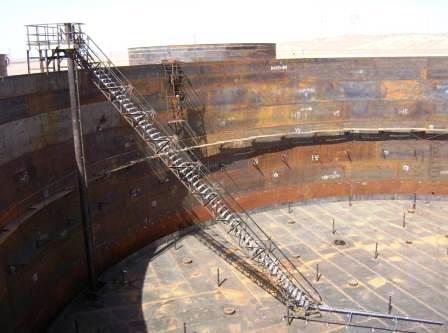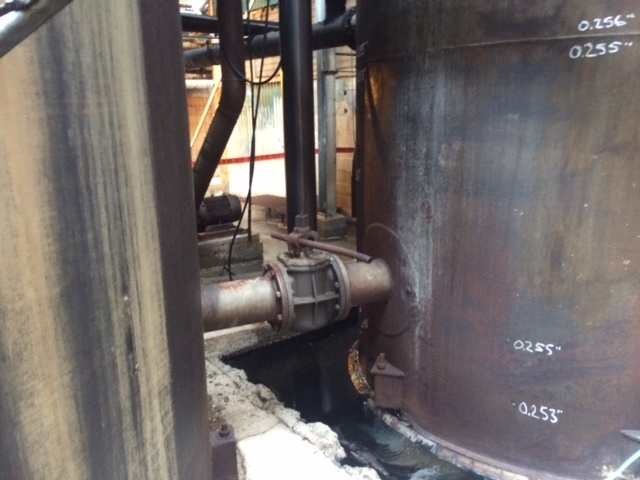How API 650 Welding Inspection Helps Eliminate Weak Welds and Promotes Safety
Wiki Article
Comprehending the Importance of Welding Assessment in Quality Guarantee Processes
Welding inspection is a necessary component of quality control in construction and production. It ensures that welds abide by well-known standards, which is crucial for architectural stability. Numerous evaluation techniques, from aesthetic to ultrasonic screening, assistance determine problems early. This aggressive technique not only protects against costly repair services however likewise improves safety. Comprehending the nuances of welding evaluation can expose its broader effects for sector compliance and credibility. API 650 Welding Inspection. What exists under the surface of these methods?The Role of Welding Inspection in Quality Control
While welding is a crucial procedure in numerous sectors, its top quality and honesty pivot considerably on reliable assessment practices. Welding assessment acts as a safeguard, ensuring that welds satisfy established standards and specs. This procedure not only recognizes problems but likewise analyzes the overall craftsmanship, consequently adding to the safety and security and long life of welded frameworks. Assessments are indispensable to high quality guarantee, as they assist prevent pricey failings and preserve compliance with sector laws. By using competent inspectors, companies can boost their functional efficiency and support their track records. Furthermore, the insights obtained from evaluations can educate constant renovation, causing better approaches and training for welders. Ultimately, welding examination functions as a vital web link in the high quality assurance chain, ensuring that every joint is qualified and reputable of enduring the rigors of its desired application. This diligence is crucial for the stability of infrastructure and the safety of end individuals.Kinds Of Welding Inspections
Welding assessments include a variety of methods designed to evaluate the top quality and stability of welds. These evaluations are necessary in making certain conformity with industry requirements and specs. Common sorts of welding examinations include aesthetic assessment, which enables prompt recognition of surface area abnormalities; ultrasonic testing, which utilizes high-frequency sound waves to detect inner imperfections; and radiographic screening, utilizing X-rays or gamma rays to reveal weld stability below the surface (API 650 Welding Inspection). Furthermore, magnetic particle testing is utilized to recognize surface area and near-surface suspensions in ferromagnetic products, while color penetrant testing supplies an approach for revealing surface-breaking issues. Each sort of evaluation serves a details objective, adding to the total high quality guarantee procedure. By employing a combination of these strategies, inspectors can offer a detailed evaluation of welding quality, eventually ensuring the safety and dependability of bonded structuresTypical Issues Identified in Welding
A selection of common issues can happen throughout the welding procedure, affecting the honesty and performance of bonded frameworks. These flaws consist of porosity, which involves entraped gas pockets within the weld, weakening its stamina. Cracks might also form as a result of fast air conditioning or improper joint style, bring about possible failing under tension. Incomplete fusion occurs when there is inadequate melting of the base steel, leading to weak bonds. An additional issue, damaging, entails the elimination of base metal along the weld edge, producing a substantial architectural weak point. Additionally, excessive spatter can impact the look and demand additional cleaning or fixing. Misalignment can lead to uneven weld grains, endangering the overall quality. Determining these flaws early through proper assessment techniques is important to assure the dependability and safety and security of bonded parts, ultimately guarding the performance of the entire framework.
Benefits of Routine Welding Inspections
Normal inspections play a substantial duty in keeping the quality and safety of welded frameworks, particularly because of the typical problems formerly outlined. These examinations supply an opportunity to identify and correct issues prior to they intensify into significant troubles, guaranteeing architectural honesty. By identifying problems early, organizations can minimize repair service prices and avoid possible task delays.Furthermore, normal welding evaluations improve conformity with market requirements and guidelines, promoting count on among stakeholders. This adherence not only secures the firm's credibility however likewise contributes to enhanced safety for employees and the public.
In addition, regular inspections promote much better training and skill development for welders, as feedback from inspections can direct improvements. Inevitably, the advantages of routine welding evaluations prolong past immediate quality guarantee, advertising long-term functional efficiency and dependability in welded frameworks.
Ideal Practices for Effective Welding Examination
Applying best you could try these out practices in welding assessment is crucial for ensuring the greatest standards of top quality and safety and security. Examiners need to be effectively trained and licensed, possessing an extensive understanding of welding strategies and products. Making use of advanced inspection innovations, such as ultrasonic screening and click here to find out more radiography, enhances the discovery of flaws that might not be noticeable to the nude eye. Establishing a clear examination strategy, describing the criteria and frequency of evaluations, warranties uniformity and thoroughness.

Documenting all findings carefully is essential for traceability and accountability. Regular calibration of assessment devices assures precision, while keeping a clean and well organized work space minimizes the threat of contamination. Furthermore, fostering open interaction among group members helps with the sharing of understandings and advertises a society of high quality. By adhering to these best techniques, organizations can especially improve their welding quality assurance procedures, ultimately leading to much safer and extra dependable products.

Regularly Asked Questions
What Qualifications Are Required for a Welding Examiner?
A welding inspector commonly calls for qualification from acknowledged companies, such as the American Welding Culture (AWS) or the International Institute of Welding (IIW), in addition to pertinent experience and understanding in welding procedures and high quality criteria.Just How Frequently Should Welding Inspections Be Done?
Welding inspections need to be carried out frequently, typically at different task phases, consisting of before, throughout, and after welding procedures - API 650 Welding Inspection. The frequency frequently relies on project specifications, regulative requirements, and the intricacy of the welds included
What Are the Costs Connected With Welding Evaluations?
The expenses connected with welding assessments vary commonly, typically varying from a couple of hundred to numerous thousand bucks, relying on variables like evaluation type, task dimension, and location, affecting total project budgets and timelines.Can Welding Inspections Be Conducted Remotely?
Yes, welding assessments can be performed from another location utilizing advanced innovations such as drones, electronic cameras, and ultrasonic testing. These approaches allow examiners to analyze weld honesty without being literally existing, boosting performance and safety and security in different atmospheres.Just How Do Assessment Outcomes Effect Job Timelines?
Evaluation results can substantially influence job timelines by recognizing problems early, causing essential rework or adjustments. Delays may happen if assessments expose problems requiring resolution, ultimately affecting total task conclusion and budget plan adherence.Welding assessments incorporate a variety of methods developed to evaluate the top quality and honesty of welds. Usual types of welding examinations consist of visual assessment, which enables for prompt recognition of surface area abnormalities; ultrasonic testing, which utilizes high-frequency audio waves to detect interior defects; and radiographic testing, utilizing X-rays or gamma rays to expose weld honesty below the surface. Constant inspections assist in far better training and skill advancement for welders, as comments why not try here from assessments can assist renovations. Implementing best techniques in welding inspection is essential for ensuring the highest standards of quality and safety. Welding examinations must be performed frequently, normally at different job stages, including before, during, and after welding procedures.
Report this wiki page